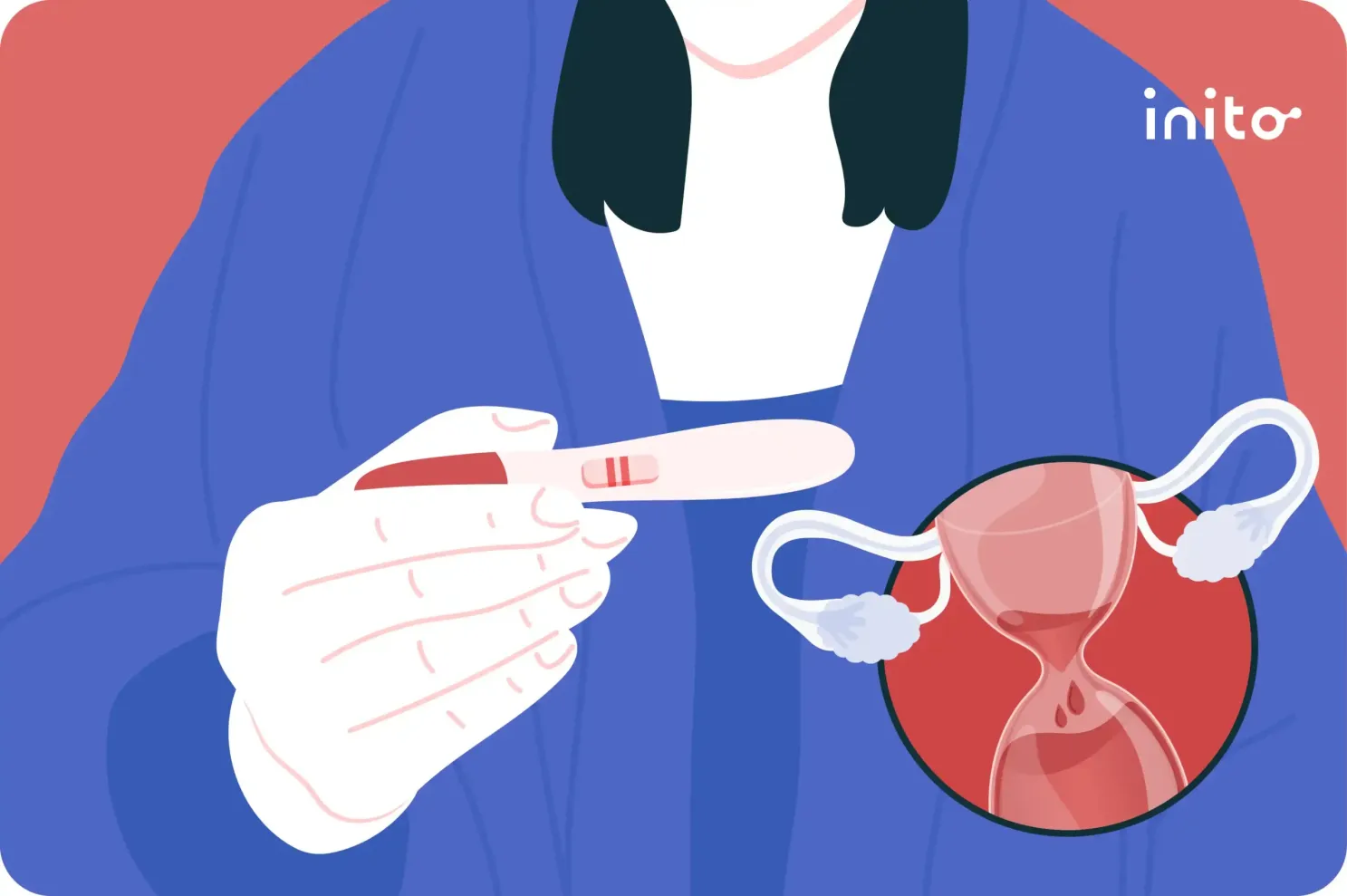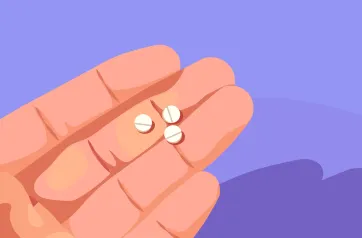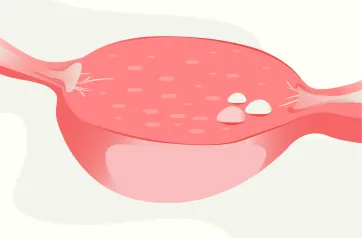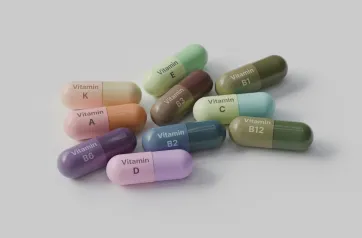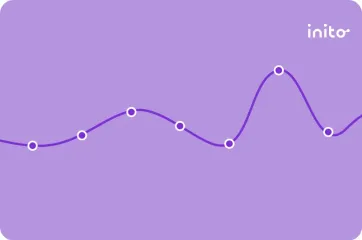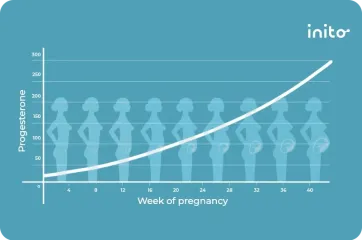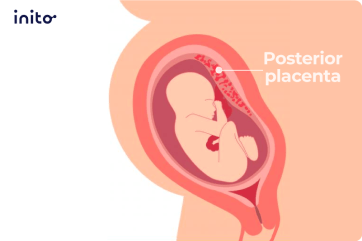Content table
Hot flashes. Night sweats. Irregular menstrual periods. Mood swings. Hormonal chaos. Perimenopause brings about a lot of changes in a woman’s daily life.
So it’s only natural for your mind to race with questions about what this all means for your fertility. Can you get pregnant during perimenopause? What are the chances? How can you tell if you are pregnant during perimenopause?
Let’s get straight to it.
The odds of getting pregnant while perimenopausal do drop. But it is still possible to get pregnant during this time. Between the ages of 40 and 44, the natural pregnancy rate typically hovers around 10%. And from ages 45 to 49, natural pregnancy rates are closer to 2-3%.
Of course, there’s much more beyond these numbers. So keep reading to learn everything about perimenopausal pregnancy.
Key Takeaways
- Perimenopause is the time when you are transitioning into menopause. Menopause is marked by the time when a woman’s periods stop and her ovaries no longer release eggs.
- The average age for perimenopause to begin is mid-40s. But the exact timing depends on each person’s unique menstrual periods.
- During perimenopause, you’ll begin to have irregular or missed periods. And you’ll also experience hormonal changes.
- It is possible to conceive during perimenopause. This includes both natural pregnancies and pregnancies aided by ART.
- Some symptoms of perimenopause are similar to early pregnancy symptoms. So the best way to tell if you are pregnant or not is to take a pregnancy test.
- If you’re TTC in perimenopause, there are ways to boost your chances. You can optimize your lifestyle to increase your egg quality. You can also look into fertility treatments like IVF or consider using donor eggs.
- Take hormone tests or use a fertility monitor like Inito to help you track changes in your fertility hormones and give you a better idea of what’s going on with your cycles.
- Certain pregnancy complications like premature birth, miscarriage, and high blood pressure are more common in perimenopausal women.
What Is Perimenopause?
The transition period of hormonal and physical changes leading to menopause, when you no longer menstruate, is known as perimenopause. In Latin, “Peri” means “around”. So, perimenopause means you are “around” or “approaching” menopause.
Menopause marks the end of your reproductive years. But it doesn’t happen overnight. It’s a gradual process that occurs over several years, and you refer to this time as the perimenopause period.
For many women, perimenopause begins around their mid-40s and lasts for up to 10 years. For example, you could be in perimenopause from age 45 to 55. But the exact start time and length of perimenopause vary from woman to woman.
One of your first perimenopause clues is having irregular menstrual cycles. And once you haven’t had a period for 12 months, you are considered to be in menopause.
Because this period varies by individual, it hasn’t been well-defined in sexual and reproductive healthcare. Sadly, this can confuse women who still have hopes to conceive.
Can You Get Pregnant During Perimenopause?
Perimenopause pregnancy is possible. But it’s more challenging to get and stay pregnant.
Why?
Here’s the short answer:
During perimenopause, hormones become out of balance, and the number of healthy eggs decreases significantly. Both of these factors greatly impact your ability to conceive.
Now, let’s get into the details.
During perimenopause, your estrogen level decreases. These lower estrogen levels cause irregular cycles and affect the ability of your Luteinizing Hormone (LH) to surge.
Without an adequate LH surge, you may experience more anovulatory cycles, with no egg released. Thus, your body doesn’t ovulate regularly and goes overdrive to grow your follicles. As a result, there’s an increase in the production of Follicle-Stimulating Hormone (FSH) and LH.
Now, with the increase in LH and FSH, if you do ovulate, there’s a chance that your egg quality may be poor. This makes it harder for the egg to become fertilized and for the embryo to implant.
Furthermore, a lower egg supply also results in a decrease in Anti-Müllerian Hormone (AMH). This throws off your hormonal balance even more.
But, the good news is that despite all these changes, pregnancy can still happen.
And there’s plenty of research and successfully pregnant women to prove it!
Since 2016, live birth rates for women between 40 and 44 have been on the rise (actually, for this age group, the birth rate has been steadily increasing since 1985).
And, for women under 50, live birth rates have trended upward since 1997.
This is hopeful news for women nearing menopause who still want to try for a baby. However, certain factors can impact pregnancy success rates. More on these next!
What Affects Your Chances of Getting Pregnant in Perimenopause?
There are quite a few factors that affect your ability to get pregnant during perimenopause. These include age, how far into perimenopause you are, your health conditions, and using (or not using) ART (Assisted Reproductive Technology).
Let’s discuss these in detail:
Age
Younger women with no known health or fertility issues have an easier time getting pregnant than older women. The main reason for this has to do with a woman’s ovarian reserve declining with age.
Know more: What Are My Chances of Getting Pregnant By Age? Check Out Our Chart
Stage of perimenopause
During early perimenopause, you may have irregular periods, and your cycle length may vary by 7 days or more. But your chances of conception at this time are higher. As you get closer to menopause, the chances of conceiving decrease.
During late perimenopause, your cycles become even more irregular. And you could go up to 2 months or longer without having a period. If attempting pregnancy naturally, you have way fewer opportunities since you have to wait long before you ovulate again.
Certain medical conditions
Medical conditions such as fibroids, PCOS, endometriosis, and hormonal imbalances make conceiving a challenge. But, one surprising outlier is PCOS. For some reason, women with PCOS seem to experience a slower decrease in fertility.
One study found that aging PCOS patients sustain fertility outcomes compared to aging women with regular menstrual cycles. Another study reported similar findings. For non-PCOS patients, fertility treatment outcomes declined more quickly than they did for PCOS patients.
Natural cycles vs. ART cycles
Fertility treatments (or lack thereof) affect your chances of pregnancy during perimenopause. Here’s what the odds of pregnancy look like in a natural cycle:
At age 40 (with no known fertility issues), your chance of getting pregnant is 5% per cycle. This means out of one hundred 40-year-old women TTC (Trying To Conceive), only 5 would get pregnant naturally in a given cycle. In comparison, natural pregnancy rates for a 30-year-old are 20% per cycle.
Of course, these are only statistics to give you a general idea. However, overall, you can see that pregnancy rates drop significantly in natural conception cycles from age 30 to 40.
Here’s what the odds of pregnancy look like with IVF:
One study of IVF patients over 40 found that pregnancy rates were 16.9% and live birth rates were 13.7%.
Keep in mind that IVF (In Vitro Fertilization) is only one form of assisted reproduction. There are other less invasive fertility treatments available as well. These can include medications and Intrauterine insemination (IUI). However, IVF may be the most effective treatment method for women in perimenopause.
Besides fertility treatments, most of these factors are out of your control. But there are other factors you can control to boost your fertility during perimenopause.
Keep reading to see what you can do.
Are There Ways to Increase Your Chances of Getting Pregnant During Perimenopause?
Yes, there are a few things you can try!
Here’s what we suggest:
- Take steps to improve your egg quality. This can include steps such as maintaining a healthy diet and managing stress.
- Track your hormones throughout each menstrual cycle to gain insight into your fluctuations. The Inito fertility monitor helps you track LH, estrogen, PdG, and FSH on a single test strip. This will help you see if you are actually ovulating or not.
- Talk to a fertility specialist or healthcare professional to learn more about ART options.
- Fertility treatments like IVF may improve your chances of pregnancy.
Consider using donor eggs if your egg quality is not adequate for a healthy pregnancy.
Let’s say you do get pregnant while in perimenopause. How exciting! However, you may have concerns about the risks you may face during pregnancy. Let’s talk about this.
Is It Risky to Conceive During Perimenopause?
Yes, pregnancy can be riskier when you are in perimenopause. Let’s break down where the increased risk comes into play.
As maternal age increases, there’s an increased chance of:
- Chromosomal abnormalities
- Miscarriage or stillbirth
- Maternal co-morbidities like hypertension or gestational diabetes
- Preterm birth (delivering before 37 weeks) (One study found that the rate of preterm birth was 30% higher for mothers 35 or older.)
- Lower fetal birth weight
- Having to deliver via a C-section
We know this may sound scary if you’re already pregnant or trying to conceive during perimenopause. However, keep in mind that there are risks associated with any pregnancy, regardless of age. With careful monitoring by your healthcare provider, you can improve your chances of having a safe and successful pregnancy.
Now, let’s say you’ve been having out-of-the-ordinary symptoms lately. And you’re not 100% sure if they’re from perimenopause or if you’re pregnant.
Because let’s face it, perimenopause and pregnancy can both make you feel like your body is out of whack. In the next section, we’ll go over how to tell the difference.
How Do I Know if It's Perimenopause or Pregnancy?
One of the telltale signs of perimenopause is having irregular periods or missed periods.
Well, if you’re trying to conceive, this is pretty confusing, right?
Unfortunately, many pregnancy symptoms and perimenopause symptoms do overlap.
But here’s a quick glimpse at how you may be able to tell between the two:
Perimenopause | Both | Pregnancy |
Hot flashes Vaginal dryness Sleep disturbances | Missed period Mood swings Constipation Increased urination Fatigue | Nausea Increased vaginal discharge Cramping Implantation bleeding Breast fullness or tenderness Food aversions |
As you can see, trying to self-diagnose based on symptoms will be challenging. So, taking a pregnancy test is the only way to confirm.
And if you already took a pregnancy test and are confused with the result, consult a healthcare professional. They can perform additional tests if necessary to see if you are pregnant.
And if you’re looking for a way to track your symptoms better, consider using the free app that pairs with the Inito Fertility Monitor.
Inito allows you to track 4 fertility hormones: LH, estrogen, PdG, and FSH on a single test strip. With all this helpful data, you can see whether you’re ovulating and how your symptoms correlate with your hormone levels. Think of it as a visual way to make sense of all the changes happening to your body.

FAQs
Yes, you can. This is because ovulation may still happen without any menstrual bleeding in the weeks prior. If you think you’ve had a missed period or could be pregnant, take a pregnancy test. That will be the only way to tell for sure!
One study found that natural pregnancy rates for women ages 45 to 49 were 2-3%. But keep in mind that the chances of pregnancy depend on a lot of factors besides age. The stage of perimenopause, your overall health, and ART treatments all play a role too.
The length of time a woman spends in perimenopause varies woman to woman. But one symptom that may help tell how far into it you are is the spacing between your periods.
When you first enter perimenopause, your menstrual cycle lengths vary by a week or so. But the farther in you are, the more spread out your cycles become. When you’re in the later stages, they can be spaced out by a few months.
There is no set limit on the age a woman can get pregnant on her own. It all depends on each woman’s unique cycle and when they stop ovulating.
At the time of this article, the oldest natural pregnancy recorded was at age 59. The mother’s name was Dawn Brooke, and she gave birth in 1997.
Was this article helpful?
- Oldest Mother to Conceive Naturally – Guinness World Records
- Contraception During Perimenopause: Practical Guidance – PMC
- Perimenopausal Bleeding and Bleeding After Menopause | ACOG
- Births: Final data for 2017
- Management of the Perimenopause – PMC
- Sustained fertility from 22 to 41 years of age in women with polycystic ovarian syndrome – PMC
- A Slower Age-Related Decline in Treatment Outcomes After the First Ovarian Stimulation for in vitro Fertilization in Women With Polycystic Ovary Syndrome
- Age and Fertility
- Ovarian stimulation and intrauterine insemination in women aged 40 years or more
- Association between maternal age at childbirth and child and adult outcomes in the offspring: a prospective study in five low-income and middle-income countries (COHORTS collaboration)
- Pregnancies in Women Aged 45 Years and Older – a 10-Year Retrospective Analysis in Berlin – PMC
- Association between maternal age at childbirth and child and adult outcomes in the offspring: a prospective study in five low-income and middle-income countries (COHORTS collaboration)
- Live-Birth Rate Associated With Repeat In Vitro Fertilization Treatment Cycles | Neonatology | JAMA




